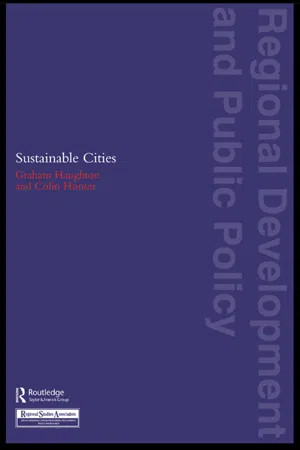Geography
Thermal Pollution
Thermal pollution refers to the degradation of water quality due to changes in water temperature caused by human activities. This can occur when industrial processes or power plants release heated water into natural water bodies, disrupting aquatic ecosystems and harming aquatic life. Thermal pollution can lead to reduced oxygen levels in water, affecting the balance of aquatic ecosystems.
Written by Perlego with AI-assistance
Related key terms
1 Key excerpts on "Thermal Pollution"
- eBook - ePub
- Graham Haughton, Colin Hunter(Authors)
- 2004(Publication Date)
- Routledge(Publisher)
Of the other hydrological changes which frequently follow urbanisation, the reduction in groundwater replenishment is ironic given the lengths that some urban authorities are going to in order to secure groundwater supplies (see previous section). Nevertheless, reduced groundwater replenishment is an important issue for urban areas. Groundwater recharge in Moscow, for example, was found to be 50% less than in another, rural, site in the Moscow River basin (Ward and Robinson 1990). This phenomenon provides another example of the way in which water quantity and water quality considerations are interlinked. Reduced river flows between storms, brought about by decreased groundwater recharge, effectively reduce the pollution dilution potential of the river, thus leading to poorer river water quality at certain times. Even during periods of high river flow when pollution dilution potential is greatest, water quality may still be poor. One reason for this may be the use of combined storm water and sewage systems in many urban areas. The provision of overflows in the sewage system to cater for surface water run-off during storms often permits mixed sewage and storm-water to bypass sewage treatment works and enter nearby streams and rivers untreated. This can create severe pollution problems.5.3GENERAL WATER POLLUTION
Water pollution can adversely affect the functioning of aquatic ecosystems, human health, agriculture, industry, transport, mineral exploitation and the aesthetic and amenity value of water resources. Pollution of fresh waters and the marine environment is a major local and regional problem around the world, especially near large urban/ industrial centres. Where pollution is severe, the complete loss of an economically valuable biological resource may result. In the estuary of the River Tees in northern England, for example, rapid industrial development and dramatic increases in the human population over two or three decades eliminated the fishery there by 1937 (Abel 1989). Similarly, the Huangpu River which flows through the city of Shanghai in China is treated as an open sewer for domestic and industrial waste, and has been essentially devoid of aquatic life since 1980 (McMichael 1993). Lake Maryut in Egypt receives much of the domestic and industrial wastes from the nearby city of Alexandria. This pollution has resulted in an 80% decline in fish populations over the last decade (Hardoy, Mitlin and Satterthwaite 1992).Water pollution comes in a huge variety of forms. Lack of space prevents all of these being discussed here in any great detail, and the following sections concentrate on a number of pollutants which have a significant urban origin and which are currently giving cause for concern. The major classes of water pollution and their sources and effects are given in Table 5.2 . No attempt is made below to separate pollutants of the fresh water and marine environments. While some forms of water pollution are more prevalent in one or other of these aquatic environments, all of the pollutants listed in Table 5.2
Learn about this page
Index pages curate the most relevant extracts from our library of academic textbooks. They’ve been created using an in-house natural language model (NLM), each adding context and meaning to key research topics.
